The .30-40 Krag was a revolutionary centerfire rifle cartridge when it first came on the scene in the 1890s, but is it still a good choice for most hunters?
When they close their eyes and try to imagine a .30 caliber rifle cartridge that started off in service with the Army and then entered widespread use with civilian hunters and shooters, most American hunters likely picture the .30-06 Springfield. However, that sequence of events also perfectly describes history of the .30-40 Krag, which came on the scene over a decade before the .30-06.
The old .30-40 Krag is nowhere near as popular among hunters these days as the .30-06 or any of the more recently developed magnum cartridges. Like the venerable .30-30 Winchester, the .30-40 Krag does not have very impressive ballistics on paper. Even so, the cartridge was very popular among particular segments of the hunting community during the 20th Century and still has a very dedicated following to this day.
In this article, I’m going to discuss why the .30-40 Krag is still hanging around these days despite its advanced age. I’ll also provide some information on how the .30-40 Krag stacks up next to the .30-06 Springfield so you can decide which one best fits your needs as a hunter.
Before we get started, I have an administrative note:
Some of the links below are affiliate links. This means I will earn a small commission (at no extra cost to you) if you make a purchase. This helps support the blog and allows me to continue to create free content that’s useful to hunters like yourself. Thanks for your support.
.30-40 Krag History
In the late 1800s, the US Army decided to replace the Trapdoor Springfield rifle and .45-70 Government round after nearly two decades of use. While they provided many years of dedicated service for the military, Army leadership wanted to move on from black powder cartridges and single shot rifles.
The Army eventually selected the bolt-action Springfield Model 1892 rifle chambered in the new .30 U.S. Government cartridge in 1892. While the cartridge has gone by many other names over the years like .30 U.S. Army, .30 U.S.A, .30 Army, and .30 Government, it’s best known as the .30-40 Krag.
Though the cartridge did not have an extremely long run as the standard rifle cartridge for the U.S. Army, the .30-40 Krag has the distinction of being the first American military rifle cartridge designed from the start to use smokeless powder.
Like the .30-30 Winchester, the .30-40 Krag used the black powder naming convention in common use at the time that consisted of the caliber of the cartridge followed by the standard load of powder in grains. Since the new Army cartridge used a .30 caliber bullet (.308″ diameter) propelled by 40 grains of smokeless powder, the cartridge received the designation “.30-40.”
The “Krag” portion of the cartridge name was an ode to Captain Ole Herman Johannes Krag, a Norwegian military officer who designed the Krag–Jørgensen rifle in partnership with Erik Jørgensen. Coming along at a time of rapid technological developments, the new bolt-action Krag–Jørgensen repeater exemplified a big step forward in gun design compared to the single shot and lever-action rifles in common use at that time.
Not surprisingly, several different countries adopted the Krag repeating rifle for use by their military. For instance, Norway adopted Krag–Jørgensen rifles (the Norwegian Krag) chambered in 6.5x55mm Swedish as their standard infantry rifle at the end of the 19th Century.
The U.S. Army adopted a slightly modified version of the rifle chambered in .30-40 Krag as the Springfield Model 1892. The Springfield Armory produced several different variants of Krag rifles and carbines for use by the Army during the 1890s until the 1903 Springfield supplanted the Krag in the early years of the 20th Century as the standard US military rifle.
Developed during a time of rapid change in rifle and cartridge development, the overall design of the .30-40 Krag incorporates characteristics from older as well as more modern eras.
As you can see in the photo below, the .30-40 Krag has a rimmed bottlenecked case.
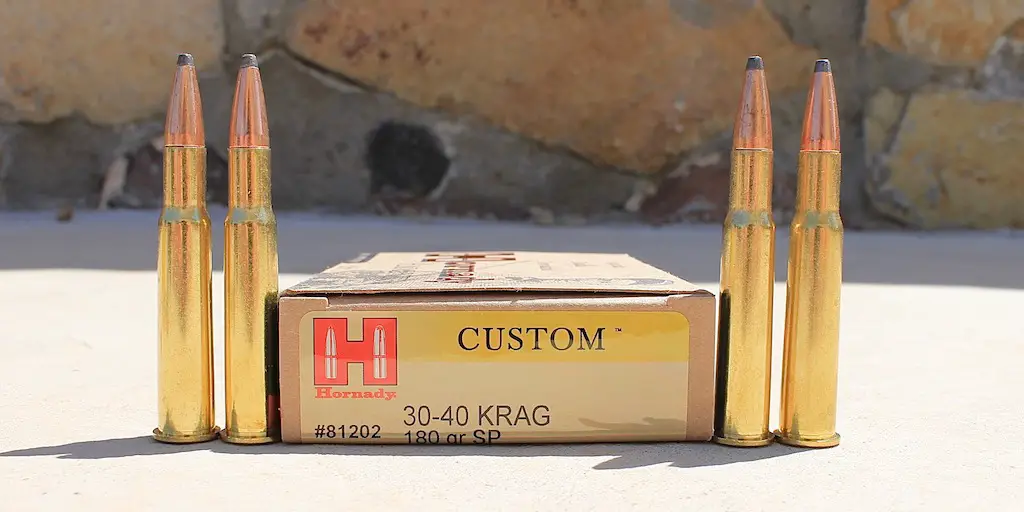
Earlier metallic cartridges like the .45-70 Government, .50-90 Sharps, and .50-110 Winchester all used straight walled rimmed cases. Loaded with black powder, those cartridges fired heavy, large caliber bullets at a relatively slow velocity.
Since smokeless propellents were much more efficient than black powder, cartridges loaded with smokeless powder could push bullets at significantly higher velocities than was previously possible. This in turn allowed hunters to use smaller caliber bullets that were lighter, more aerodynamic, and had a correspondingly flatter trajectory than the bullets used in the previous generation of the big bore rifles.
So, the late 19th Century saw the introduction of a number of smaller caliber, high velocity rifle cartridges loaded with smokeless powder that used a bottlenecked case. Some of those cartridges (like the .30-40 Krag, .303 British, and 7.62x54R) continued to use a rimmed case for headspacing.
However, if not loaded in a magazine with care, rimmed cartridges can hang up and cause issues with feeding in bolt-action rifles. For that reason, cartridge design quickly progressed to rimless cases like those used by the 7mm Mauser and .30-06 Springfield.
All things considered though, the Krag–Jørgensen rifle received high marks for having an exceptionally smooth action and for offering excellent accuracy. The new .30-40 Krag was also a big hit with the military and offered a big step up in performance when compared to the other rifle cartridges available at the time.
30-40 Krag Ballistics
The original 30-40 Krag ballistics were a 220 grain bullet at 2,000 fps (1,954 ft-lbs). Modern .30-40 Krag factory loads fire a 180 grain bullet at approximately 2,430 fps (2,360 ft-lbs). Those loads are perfect for game like deer and elk at short to moderate range.
Impressed by the performance of the cartridge, Remington and Winchester both rushed to offer rifles and ammunition for civilian hunters and shooters in the years following adoption of the cartridge by the Army. Though the .30-06 Springfield has since eclipsed the .30-40 Krag in terms of popularity among American hunters, the Krag was still widely used throughout most of the 20th Century.
30-40 Krag vs 30-06
The .30-06 Springfield has a longer case that can hold more powder than the .30-40 Krag. For this reason, the .30-06 can fire the same weight bullet approximately 200-300fps faster than the .30-40. This results in a flatter trajectory, more resistance to wind drift, and more retained energy at longer range.
That’s how the two cartridges compare to each other in a nutshell. As we drill down into the history of the development of the .30-06, you’ll see how and why they’re similar and different.
While .30-40 Krag was a well designed cartridge and performed ably in the hands of American Soldiers during the cartridge’s short service in Cuba and the Philippines, the Army received a sobering lesson regarding the effectiveness of the 7mm Mauser during the Spanish-American War. For this reason, Army leaders wanted a cartridge and rifle that could compete with the revolutionary new Mauser.
As good as the .30-40 Krag and the Krag–Jørgensen were, the cartridge and rifle simply did not offer the sort of performance desired by the U.S. Army in the early 1900s. In particular, the Krag rifles only had a single locking lug and therefore weren’t strong enough to handle higher pressure cartridges. The rifles also could only be loaded one round at a time, instead of using a stripper clip like the Mauser.
So, the U.S. Army set about designing a new rifle and cartridge to replace the Krag. The new rifle they selected, the 1903 Springfield, basically copied the design of the Mauser rifle.
Designers also initially built a new cartridge called the .30-03 Springfield.
Also known as the .30-45, the cartridge used a rimless case that was very similar in overall appearance to the 7mm Mauser case. The .30-03 also had a larger powder charge than the .30-40 Krag and fired the same 220 grain round nosed bullet at slightly faster velocity of approximately 2,300 feet per second.
However, the Army changed that load and replaced the 220 grain round nose bullet with a 150gr spitzer (pointed) bullet fired at a muzzle velocity of 2,700fps. Renamed the .30-06 Springfield, this new cartridge had a much flatter trajectory and offered better energy retention at longer range than the .30-40 Krag.
The .30-40 Krag and the .30-06 Springfield both fire the same .308″ diameter bullets though.
There is also a lot of overlap in the common bullet weights they use. For instance, the 30-06 commonly uses bullets in the 110-220 grain range with 150 grain, 165 grain, 180 grain, and 200 grain bullets being most common. The .30-40 Krag typically typically uses bullets in that same range, but 180 grain, 200 grain, and 220 grain bullets are most common with it.
Since there’s so much overlap in their common bullet weights, rifles for both cartridges typically use a 1:10″ rifling twist.
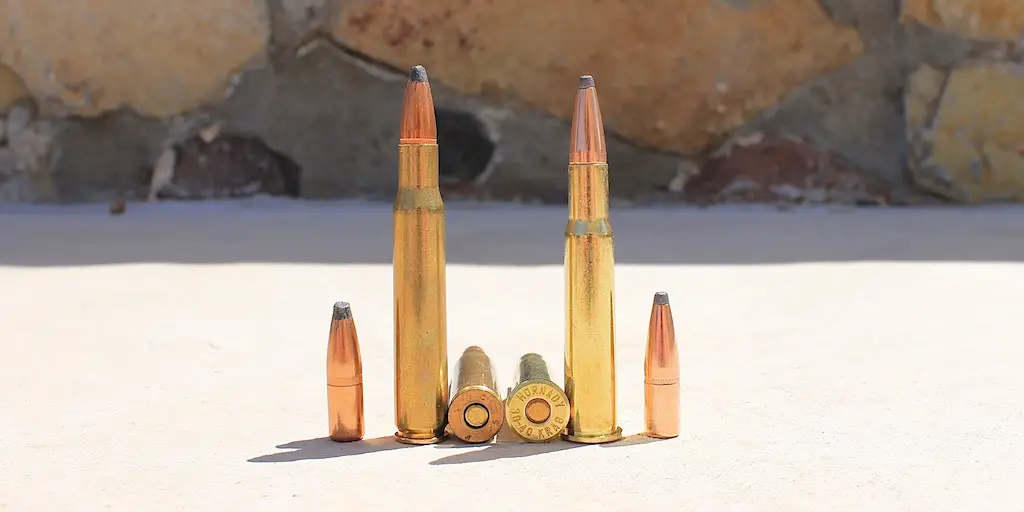
The .30-06 has a longer (2.49″ vs 2.31″) case with less taper and a shoulder moved farther forward than the .30-40 Krag. For that reason, the .30-06 has about 20% more case capacity than the .30-40 Krag. The .30-06 also has a higher SAAMI maximum pressure.
Those two factors are why the .30-06 can fire the same weight bullet quite a bit faster than the .30-40 Krag.
Additionally, the .30-06 has a rimless case while the .30-40 Krag has a rimmed case.
The fact that the .30-06 Springfield has a rimless case is something of an advantage when it comes to reliable feeding in bolt action rifles. On the other hand, as previously stated, rimmed cases can hang up and cause a jam if they’re not loaded in a magazine with care
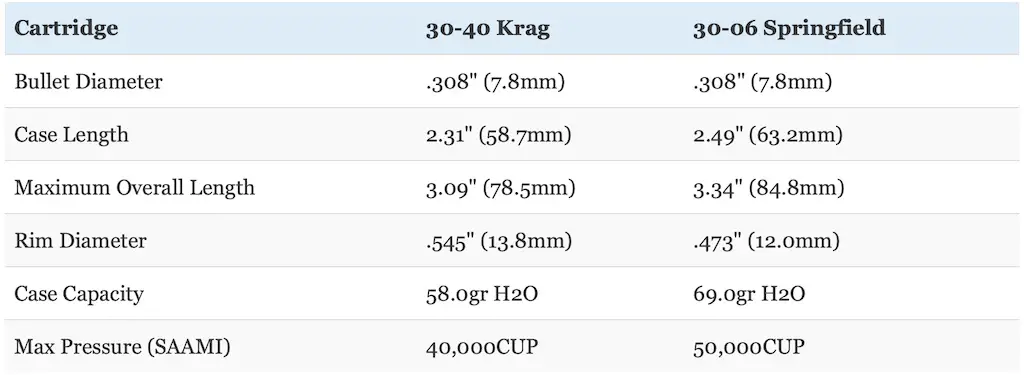
Note: while the powder capacity figures listed above do give a good indication of the differences between the two cartridges, exact case capacities vary slightly according to the brand of brass used.
The table below compares Hornady factory loads shooting 180gr Hornady InterLock (.425 BC) loads for each cartridge as well as a load for the .30-06 from the Hornady Precision Hunter line using a 178gr Hornady ELD-X bullet (.552 BC) All of these loads used a 24″ barrel and a 200 yard zero.
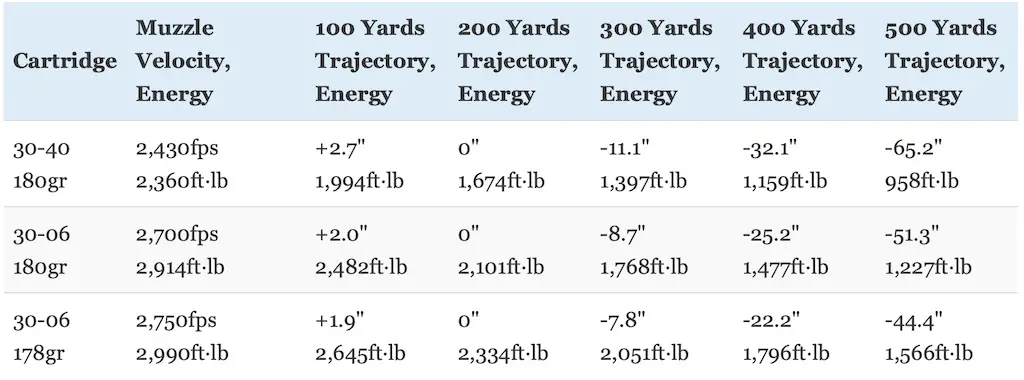
Just as you’d expect, the .30-06 has a flatter trajectory and more kinetic energy retained at longer range than the .30-40 Krag. That is especially apparent when comparing that high BC Hornady Precision Hunter load for the .30-06 to the .30-40 Krag.
However, even with the two loads using the exact same bullet are compared, that additional 270 feet per second of muzzle velocity still makes a big difference at ranges past 300 yards.
Specifically, the 180gr .30-06 load has about 13.9″ (21%) less bullet drop at 500 yards and the 178gr .30-06 load has a whopping 20.8″ (32%) less bullet drop than the .30-40 Krag at the same range. The 180gr and 178gr .30-06 loads also have about 28% and 63% more energy remaining respectively at 500 yards than the .30-40 Krag.
Though the difference in their performance is much smaller at shorter range, the two 30-06 loads still have about 25-40% more kinetic energy than the .30-40 Krag at 200 yards.
The chart below compares how much a 10 mile per hour crosswind impacts those same loads for each cartridge out to 500 yards.
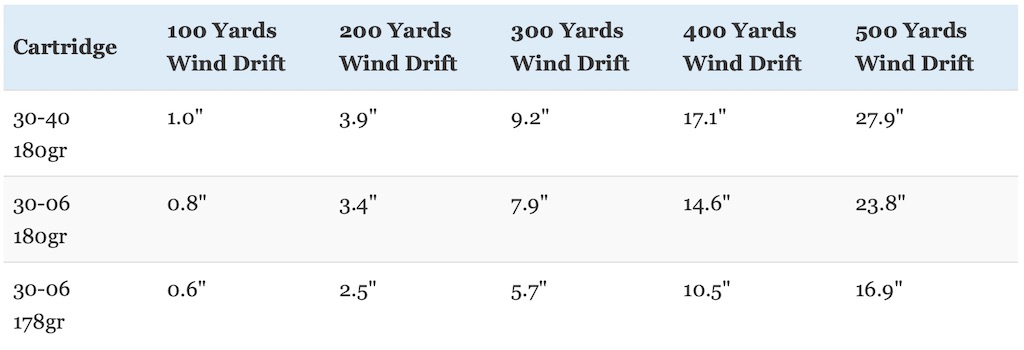
Once again, the cartridges perform pretty much like you’d expect.
At 500 yards, the .30-40 Krag has a whole lot more wind drift than the .30-06 loads. However, the difference in their performance is much smaller at shorter range.
Now let’s talk about recoil.
The table below compares a couple of handloads that approximate the performance of the factory loads given above when fired from identical rifles.
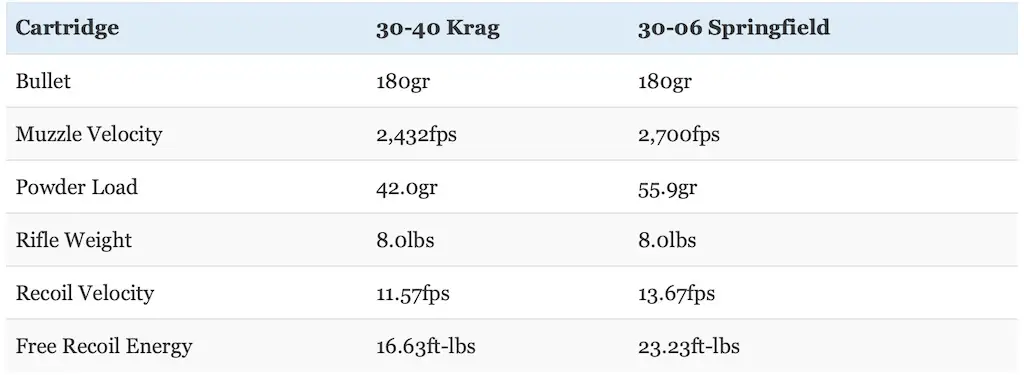
Felt recoil will vary from shooter to shooter and rifle to rifle, but free recoil energy is still a useful way to compare cartridges.
As you can see, the 30-06 delivers those ballistic advantages over the .30-40 Krag at the expense of nearly 40% more free recoil energy.
All things considered, the .30-06 Springfield does have a manageable amount of recoil that most hunters shooters should be able to handle without too much trouble. However, it’s also pretty clear that the modest ballistics of the .30-40 Krag translate into a relatively mild “kick” that makes the cartridge a good choice for the recoil shy.
So where do we stand overall with the .30-40 Krag vs 30-06 Springfield?
Basically, the .30-06 is capable of firing the same weight bullet at a faster velocity than the .30-40 Krag. That translates into a flatter trajectory, a little more resistance to wind drift, and more kinetic energy at typical hunting ranges. However, that comes at the expense of substantially more recoil.
The .30-40 Krag doesn’t offer the same level of performance as the .30-06 Springfield, but it’s certainly no slouch either. Make no mistake, the cartridge is absolutely deadly on all manner of North American big game like deer, feral hogs, and black bear.
If you want to use the .30-40 Krag for elk hunting, know that it will certainly get the job done, but it’s best suited for closer range shots. The same goes for even bigger game like moose.
Indeed, John Plute used a .30-40 Krag (probably either a Winchester Model 1895 or a Krag-Jorgensen rifle) to kill the Boone & Crockett record Rocky Mountain Elk in Colorado back in 1899. Scoring 442 3/8″, that bull was the world record until 1999. It’s currently still the #2 typical elk in the record book.
On the other hand, the additional couple hundred ft-lbs of kinetic energy the .30-06 Springfield provides might come in handy at extended range. The flatter trajectory and more resistance to wind drift of the .30-06 can also help with shot placement.
This does make the cartridge a little bit more forgiving of range or wind estimation errors than the .30-40 Krag. However, that extra recoil of the .30-06 can negatively impact shot placement with some shooters, though not to the degree of really heavy recoiling cartridges like the .300 RUM.
All things considered though, both cartridges are very accurate, flat shooting, and hit hard enough for use on a wide variety of game at practical hunting ranges. Yes, the .30-06 does have a significant ballistic advantage over the .30-40 Krag that’s especially pronounced at longer ranges, but that doesn’t mean the Krag is a lightweight.
On the contrary, the .30-40 Krag is a wonderful all-around hunting cartridge.
If we’re being honest, the vast majority of hunters will never take a shot at a big game animal at ranges past 200 yards. At those ranges, the .30-40 Krag will absolutely hammer just about any species of big game in the world and I doubt the couple hundred extra foot pounds of energy the .30-06 hits with will make much difference.
After all, dead is dead and the the .30-40 Krag is clearly powerful enough to cleanly and ethically take North American big game from whitetail deer all the way up to moose.
In fact, traditional cup and core bullets tend to perform very well on a wide range of game at the more sedate velocities of the .30-40 Krag.
This is because those traditional cup and core bullets will rapidly, sometimes explosively, expand and/or fragment at very high impact velocities encountered with other cartridges. This can result in minimal penetration and very horrific, though often quite shallow, wounds.
So it might seem counterintuitive at first, but at close range, the lower velocity .30-40 Krag will often to penetrate better and produce less bloodshot meat with those older style bullets.
At the same time, the moderate recoil produced by the .30-40 Krag is also a big plus in favor of that cartridge.
Similar to the case with the .30-30 Winchester, the .30-40 Krag is more than powerful enough to get the job done on most species of big game at short to moderate range without tooth rattling recoil or deafening muzzle blast.
Regardless of whether you’re using a .30-40 Krag or a .30-06 Springfield, no pronghorn, mule deer, or elk will go far if you put a well constructed bullet into the vitals.
Of the two cartridges though, the .30-06 Springfield is by far the most popular with hunters. This is reflected in the prices, availability, and variety of factory ammunition and hunting rifles currently in production for each cartridge.
The .30-06 Springfield is a fantastic hunting round and is one of the most popular cartridges used by hunters in the United States. Not surprisingly, it’s a whole lot easier to find .30-06 rifles and loaded ammunition. Recoil is heavier than the .30-40 Krag, but it’s still very manageable for most hunters.
For these reasons, the .30-06 Springfield is probably the better all around choice for most hunters.
That said, the .30-40 Krag is still a worthy choice for those who like to stand apart from the crowd or those who want to hunt with a piece of history.
30-40 Krag Ammo
In all honesty, there just aren’t many options for loaded .30-40 Krag ammunition. At this time, Hornady, HSM, Remington, and Winchester are the only companies I’m aware of that manufacture factory .30-40 Krag ammo.
It’s popular enough that some of the bigger retailers in the USA do keep some .30-40 Krag ammo in stock, but it’s still not the easiest stuff to find. Fortunately, you can usually find some ammunition for the cartridge online if you look hard enough.
BUY SOME 30-40 KRAG HUNTING AMMO HERE
BUY SOME MORE GREAT 30-40 KRAG HUNTING AMMO HERE
That said, you can cook up some good custom handloads for the .30-40 Krag if you’re a reloader. Reloading components for the cartridge aren’t exactly growing on trees, but you can still normally find what you need without too much difficulty.
Finally, since it uses the same .308″ bullet size that’s also used by the .308 Winchester, .30-06 Springfield, .300 Win Mag, .300 Ultra Mag, and .300 PRC (among others), reloaders have access to a good number of outstanding quality bullets in the 180-220 grain range suitable for use on a wide variety of game to choose from.
For instance, the Barnes TTSX, Hornady ELD-X, GMX, and InterLock, Nosler E-Tip, AccuBond, and Partition, Swift Scirocco and A-Frame are all good bullet options for the .30-40 Krag.
30-40 Krag Rifles
At this time, I’m not aware of any .30-40 Krag rifles in current production. However, a number of different firearms in that chambering were produced over the years, so it’s still possible to find a decent rifle on the secondary market.
Of those, the Krag–Jørgensen (also known as the U.S. Krag or the Springfield Krag) was probably the most popular and is the rifle most commonly associated with the cartridge. The Springfield Armory produced a number of different rifles and carbine variants between 1892 and 1899, most notably the M1892 Rifle, the M1896 Rifle, the M1896 Carbine, the M1898 Rifle, and the M1899 Carbine.
Some of these rifles and a smaller number of Krag carbines have been sporterized over the years, but others are still in their original configuration and have some value to collectors.
In addition to the .405 Winchester cartridge most commonly associated with that rifle, Winchester also produced their Model 1895 lever action rifle in .30-40 Krag for a time. The company also produced the Winchester 1885 High-Wall rifle in that cartridge as well. The same goes for Remington with their Rolling Block rifle.
Finally, Ruger manufactured a good number of the No.1 and No. 3 single shot rifles in .30-40 Krag as well.
While it’s easier to find Ruger rifles for the cartridge in good condition, things get a little more complicated with those older Winchester, Remington, and Springfield rifles. There are certainly good specimens out there though and, a well cared for example of any of those rifles should provide very good accuracy.
Best 30-40 Krag Ammo For Hunting
Even though it’s been around for a long time, the .30-40 Krag is still a very capable round in the right hands for hunting many species of big game. Considering it’s age, the cartridge is also a surprisingly popular choice for many hunters and there are currently two factory ammo choices for the .30-40 Krag: one from Remington and one from Hornady.
Remington Core-Lokt 180gr
The Remington Core-Lokt .30-40 Krag round uses a 180 grain soft point pushed at 2,430fps. This is perfect for medium game like whitetail deer, feral hogs, and black bear. This isn’t a super high velocity or very flat shooting load, but it’s still deadly on bigger game like elk and moose at shorter range. At reasonable ranges, it will certainly get the job done with good shot placement.
GET 30-40 KRAG CORE LOKT AMMO HERE
Hornady Custom 180gr
Like the Remington load above, this Hornady load fires a 180 grain bullet at 2,430fps. However, this particular load uses a bullet with a slightly higher ballistic coefficient than the Remington load. This will result in slightly better ballistics, but the difference isn’t tremendous inside 200 yards. Especially at the modest velocities encountered with this cartridge, the InterLock bullets used in this load should give reliable expansion combined with good penetration on medium and large game at reasonable ranges.
GET HORNADY 30-40 KRAG AMMO HERE
Final Thoughts On The 30-40 Krag
Don’t be fooled by the seemingly anemic performance of the .30-40 Krag on paper. While it does indeed have its limitations, the .30-40 is an outstanding choice for hunting under the right circumstances. It’s not usually thought of as a premier deer hunting cartridge, but it excels in that role and will get the job done on most other species of big game as well.
If you can find a good quality .30-40 Krag rifle and a reliable supply of ammo, then it should serve you very well. Find a load that you like, learn to shoot it accurately, and I’m sure you’ll be happy with how the .30-40 Krag performs for you afield.
Are you curious about how the 30-40 Krag stacks up against other popular (and not so popular) 30 caliber cartridges? If so, you’ll probably enjoy my podcast episode on 30 caliber cartridges. In this episode, I talk about the history, pros, cons, and recommended uses for basically everything from the 30 Carbine all the way up to the 30-378 Weatherby Magnum and 300 PRC as well as everything in between (to include the 30-40 Krag).
This is a fantastic episode, so just click the appropriate link below to listen to that episode on your preferred podcast app. Be sure to hit that “Subscribe” or “Follow” button in your podcast app to receive future episodes automatically (for free)!
Ultimate Guide To 30 Caliber Cartridges Podcast
Apple | Google | iHeart | Pandora | Spotify
Enjoy this article about the 30-40 Krag? Please share it with your friends on Facebook and Twitter.
The Lyman 50th Edition (p239-240, p246-250), Hornady 10th Edition (p498-502, 510-522), and Speer Number 10 (p228-232, 233-237) reloading manuals provided information for the history of 30-40 Krag and 30-06 Springfield as well as data used to compare their size and recoil. The data used to compare the trajectory of the cartridges was obtained from Hornady (here, here, and here). Maximum pressure for the .30-40 Krag and .30-06 Springfield were obtained from SAAMI (p17). KWK provided case capacity data for the .30-40 Krag and .30-06 Springfield. I used Shooters Calculator to compare trajectories, wind drift, and recoil for the cartridges.
Make sure you follow The Big Game Hunting Blog on Facebook, Instagram, Twitter, and YouTube.
NEXT: BEST 6.5 CREEDMOOR AMMO FOR HUNTING ELK, DEER, AND OTHER BIG GAME
John McAdams is a proficient blogger, experienced shooter, and long time hunter who has pursued big game in 8 different countries on 3 separate continents. John graduated from the United States Military Academy at West Point and is a veteran of combat tours with the US Army in Iraq & Afghanistan. In addition to founding and writing for The Big Game Hunting Blog, John has written for outdoor publications like Bear Hunting Magazine, The Texas State Rifle Association newsletter, Texas Wildlife Magazine, & Wide Open Spaces. Learn more about John here, read some of John’s most popular articles, and be sure to subscribe to his show: the Big Game Hunting Podcast.

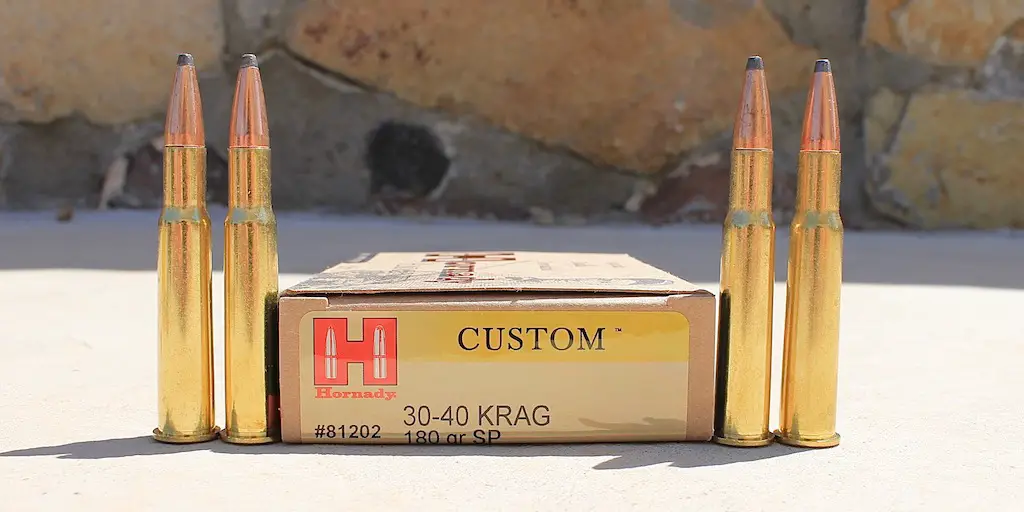

I use a 30-06 Model 70 Alaskan here in WV but as our shots are generally short, I loaded some Hornady 150 grain Spire Point InterLock to the listed Hornady max load for the same bullet in the 30-40 Krag, 2500fps, which is the minimum load listed for the 30-06. The rifle likes the load and it is a total pleasure to shoot. This coming fall will be my first chance to try it on deer (hopefully!).
My grandfather had to hunt to feed his family starting at about 9 years old after his dad died of the Spanish flu in 1918. He said that since they didn’t have refrigeration up in the hills of Southern Oregon, in the summer he had to get a deer about each week. On my first deer hunt in 1973 he was still killing deer with it. When my dad gave me the Krag about 15 years ago, I hunted with it that season in Southern Oregon. I got to tell Grandpa that the Krag got another deer. His reply was typical. “Well it should, it killed one the last time I shot it. “